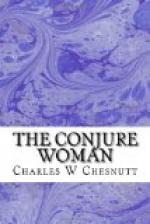Relics of ancestral barbarism are found among all peoples, but advanced civilization has at least shaken off the more obvious absurdities of superstition. We no longer attribute insanity to demoniac possession, nor suppose that a king’s touch can cure scrofula. To many old people in the South, however, any unusual ache or pain is quite as likely to have been caused by some external evil influence as by natural causes. Tumors, sudden swellings due to inflammatory rheumatism or the bites of insects, are especially open to suspicion. Paralysis is proof positive of conjuration. If there is any doubt, the “conjure doctor” invariably removes it. The credulity of ignorance is his chief stock in trade—there is no question, when he is summoned, but that the patient has been tricked.
The means of conjuration are as simple as the indications. It is a condition of all witch stories that there must in some way be contact, either with the person, or with some object or image intended to represent the person to be affected; or, if not actual contact, at least close proximity. The charm is placed under the door-sill, or buried under the hearth, or hidden in the mattress of the person to be conjured. It may be a crude attempt to imitate the body of the victim, or it may consist merely of a bottle, or a gourd, or a little bag, containing a few rusty nails, crooked pins, or horsehairs. It may be a mysterious mixture thrown surreptitiously upon the person to be injured, or merely a line drawn across a road or path, which line it is fatal for a certain man or woman to cross. I heard of a case of a laboring man who went two miles out of his way, every morning and evening, while going to and from his work, to avoid such a line drawn for him by a certain powerful enemy.
Some of the more gruesome phases of the belief in conjuration suggest possible poisoning, a knowledge of which baleful art was once supposed to be widespread among the imported Negroes of the olden time. The blood or venom of snakes, spiders, and lizards is supposed to be employed for this purpose. The results of its administration are so peculiar, however, and so entirely improbable, that one is supposed to doubt even the initial use of poison, and figure it in as part of the same general delusion. For instance, a certain man “swelled up all over” and became “pieded,” that is, pied or spotted. A white physician who was summoned thought that the man thus singularly afflicted was poisoned, but did not recognize the poison nor know the antidote. A conjure doctor, subsequently called in, was more prompt in his diagnosis. The man, he said, was poisoned with a lizard, which at that very moment was lodged somewhere in the patient’s anatomy. The lizards and snakes in these stories, by the way, are not confined to the usual ducts and cavities of the human body, but seem to have freedom of movement throughout the whole structure. This lizard, according to the “doctor,” would start




